Medicine & Health
Northeast Traditional Chinese Medicinal Material Trading Center Project of Liaoyuan City
1 Introduction to the Project
1.1 Project background
1.1.1 Product introduction
Relying on the location and resource advantages of Liaoyuan City, the Project constructs facilities such as a normal temperature cold storage, trading hall, distribution area, comprehensive service center, financial service center, and warehouse, etc. in Dongfeng County, Liaoyuan City. It aims to create a comprehensive service platform that integrates the trading, storage, processing, research and development, and logistics of traditional Chinese medicinal materials.
1.1.2 Market prospect
Equipped with abundant resources of traditional Chinese medicinal materials, China has a natural advantage in developing and expanding the traditional Chinese medicine (TCM) industry. According to statistics by the Institute of Chinese Materia Medica, China Academy of Chinese Medical Sciences, there are currently 11,146, 1,581, and 80 species of medicinal plants, medicinal animals, and medicinal minerals, respectively.
In recent years, China has attached great importance to the development of TCM cause and introduced a series of favorable policies to encourage the key development of artificial breeding technology for endangered medicinal materials, as well as seedling technology for high-quality seeds of traditional Chinese medicinal materials, to promote the standardized planting and breeding of traditional Chinese medicinal materials in China, and encourage the industrialization, commercialization, and moderate scale development of traditional Chinese medicinal materials. Up to now, the traditional Chinese medicinal material industry in China has reached the stage of large-scale, intensive, and industrialized cultivation base production, with more than 200 species planted, of which 60-70 have formed a large-scale production capacity.
In recent years, the TCM industry in China has made significant progress, which has also promoted the development of upstream planting of traditional Chinese medicinal materials. In 2023, the market size of traditional Chinese medicinal material planting industry in China was about 227.092 billion yuan, maintaining a sustained growth trend.
Table 1 Market Size of Traditional Chinese Medicinal Material Industry in China from 2019 to 2023
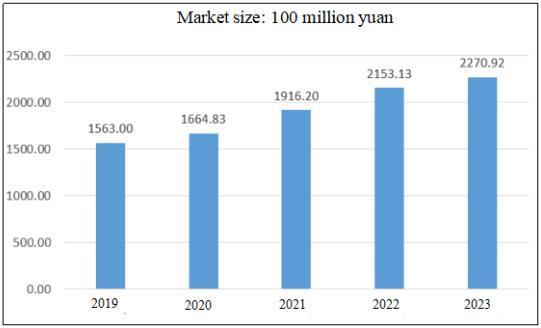
With the advancement of agricultural supply-side structural reform in China, the state’s support for the traditional Chinese medicinal material industry continues to increase. Meanwhile, with change in the population structure and continuous growth of the population, relying solely on wild resources of traditional Chinese medicinal materials is difficult to meet the demands of the people. With changes in people’s health concepts and changes in medical models, and with the complementary advantages of traditional Chinese medicine and Western medicine having become important features and significant advantages of characteristic medical and health industry in China, the species of traditional Chinese medicinal materials planted in China are becoming increasingly diverse, and the scale of traditional Chinese medicinal materials is also constantly increasing. As of 2023, the planting area of traditional Chinese medicinal materials in China has reached 56.26 million mu, with an annual output of about 5.2042 million tons.
Table 2 Planting Area of Traditional Chinese Medicinal Materials in China from 2019 to 2023
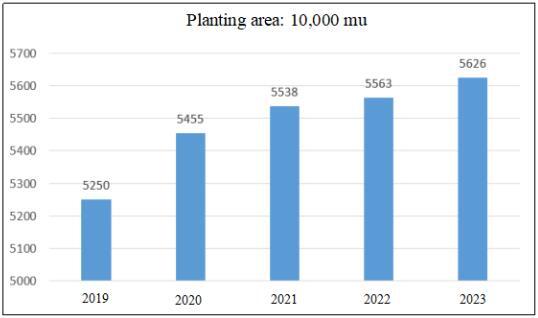
Table 3 Output of Botanical Traditional Chinese Medicinal Materials in China from 2019 to 2023
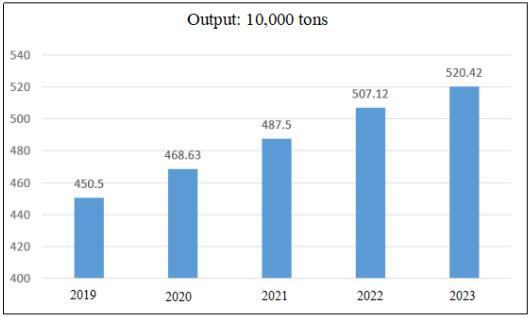
In recent years, the support for the TCM industry in China has been continuously strengthened, and a series of supportive policies have been introduced, including financial support for constructing planting bases of traditional Chinese medicinal materials and subsidies for growers of traditional Chinese medicinal materials. These policies have provided a favorable environment for the development of the traditional Chinese medicinal material planting industry. With the improvement of the people’s health awareness and the increasing recognition of TCM, the demand for traditional Chinese medicinal materials in the domestic market continues to grow. Especially with the increasing trend of population aging, the demand for traditional Chinese medicinal materials will further increase. From 2019 to 2023, the sales volume of traditional Chinese medicinal materials in China increased from 4.44 million tons to about 5.0564 million tons.
Table 4 Sales Volume of Traditional Chinese Medicinal Materials in China from 2019 to 2023

In the past 10 years, the export of traditional Chinese medicinal materials and decoction pieces in China has maintained a stable trend, with export amount ranging from US$ 1 billion to US$ 1.5 billion basically. Affected by COVID-19, the export of traditional Chinese medicinal materials and decoction pieces grew rapidly in 2020, with the export amount reaching US$ 1.32 billion, a year-on-year growth of 14.8%, which can be regarded as a high point in the past 10 years.
Table 5 Export Trend of Traditional Chinese Medicinal Materials and Decoction Pieces from 2014 to 2023
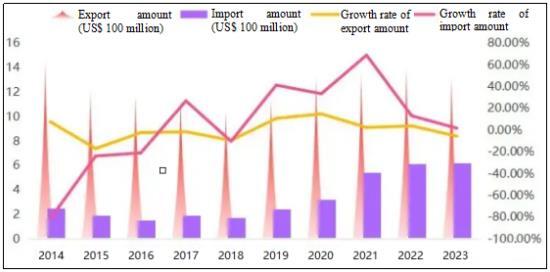
From the perspective of the import and export conditions in the segmented field of TCM products, TCM extracts ranked first with a proportion of 59.7% of the import trade, while TCM decoction pieces and TCM health products have become the main export forces with a proportion of 21.5% and 40.2%, respectively. In the long run, with policy support and improvement in the international trade environment, the import and export trade of traditional Chinese medicine products will improve in a stable way.
Table 6 Breakdown of Import and Export Trade Conditions of TCM Products in China in 2023
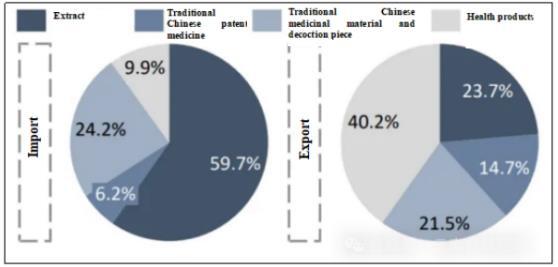
From the perspective of export market, RCEP region has become the main destination for the export of traditional Chinese medicinal materials and decoction pieces in China. Among the top ten markets, Japan, Vietnam, Hong Kong, China, South Korea, Taiwan, China, Malaysia, Singapore, and Thailand accounted for nearly 80% of the total export amount. Among the top ten markets, only Japan, Hong Kong, China, and Thailand maintained positive growth, while other markets all declined to varying degrees. In 2023, the market share in Japan reached up to 21.7%, with an export amount of US$ 286.923 million, a year-on-year growth of 15.4%. Vietnam’s annual export amount decreased by 22.3% year-on-year, mainly due to the influence of the large variety of Cinnamomum cassia. Cinnamomum cassia accounted for half of China’s exports to Vietnam. In 2023, the export amount of this product sharply decreased from US$ 141.893 million to US$ 71.596 million, with a year-on-year decrease of 49.5%.
Table 7 Top 10 Export Countries of Traditional Chinese Medicinal Materials and Decoction Pieces in China in 2023
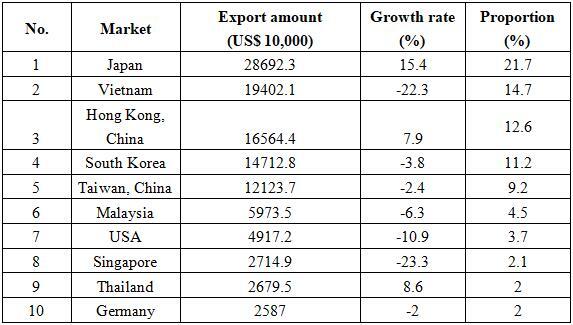
From the perspective of the import market, Asia is the main source of imported traditional Chinese medicinal materials and decoction pieces, with nearly 90% of China’s imported medicinal materials coming from Asia. In 2023, the total import amount of traditional Chinese medicinal materials and decoction pieces in China was US$ 622.367 million, with Indonesia, Canada, and Myanmar being the top three markets for imports, and the products imported from the above markets accounted for 45.3% of the total import amount. In 2023, the amount of traditional Chinese medicinal materials and decoction pieces imported from Indonesia by China was US$ 144.705 million, with a year-on-year decrease of 6.8%. Indonesia’s spice products have a relative advantage and are the focus of import in China. Myanmar ranks third among the importing countries, and the main product imported by China from Myanmar is Curcuma longa. Due to a nearly 200% increase in Curcuma longa imports in 2022, there was sufficient supply in the market with a large base, so there was a decline in imports of Curcuma longa in 2023. In addition, the Vietnamese market is worth paying attention to. In 2018, the amount of traditional Chinese medicinal materials and decoction pieces imported from Vietnam by China was only US$ 180,000. By 2023, this Table has reached US$ 38.283 million, with an average annual compound growth rate of 192.1%.
Table 8 Top 10 Import Countries of Traditional Chinese Medicinal Materials and Decoction Pieces in 2023
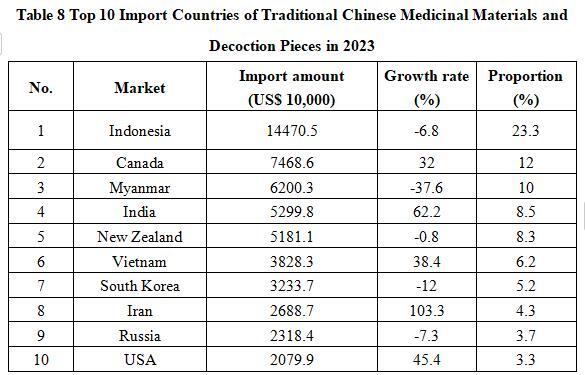
Jilin Province is one of the key production areas for traditional Chinese medicinal materials in China, and Changbai Mountain area is even one of the three major gene banks of traditional Chinese medicinal materials, containing abundant medicinal biological resources. There are a total of 2,790 species of medicinal resources in the province. Among the 363 key species of medicinal materials surveyed nationwide, there are 137 in Jilin Province, accounting for 37.7%. Among them, medicinal materials such as ginseng and cornu cervi pantotrichum have outstanding genuineness. The output of ginseng in Jilin accounts for about 60% nationwide and about 40% worldwide, while its number of raised cervus nippon accounts for about 50% nationwide The main species of genuine medicinal materials include ginseng, American ginseng, Fritillaria ussuriensis, Schisandra chinensis, Epimedium brevicornu, Gentiana cruciata, Ganoderma lucidum, Atractylodes Lancea, Asarum heterotropoides, Polygonatum sibiricum Delar, Gastrodia elata, and Saposhnikovia divaricata, etc. Data showed that, in 2023, the comprehensive output value of the ginseng industry alone in Jilin Province exceeded 70 billion yuan.
Against the backdrop of the state’s emphasis on national health and the revitalization of Northeast China, TCM in Jilin Province has made significant progress, forming a relatively complete management system for TCM and initially forming a pattern of comprehensive development in TCM treatment, health care, scientific research, education, and industry. Meanwhile, as a major province of TCM industry, Changbai Mountain in the east of Jilin Province is known as the “World’s Biological Resource Treasury” and is one of the three major famous “Gene Banks of Traditional Chinese Medicinal Materials” in China. It has a good ecological environment for the growth of natural green traditional Chinese medicinal materials, with excellent quality of traditional Chinese medicinal materials, and significant advantages in TCM resources, creating congenital conditions for the development of the province’s TCM industry. Meanwhile, it also provides a large amount of raw materials available for trade for the demand of TCM enterprises. In the future, the market size of the traditional Chinese medicinal material trade in Jilin Province will further expand.
Relying on the location and resource advantages of Dongfeng County, the project constructs facilities such as a normal temperature cold storage, trading hall, distribution area, comprehensive service center, financial service center, and warehouse, etc. It aims to create a comprehensive service platform that integrates the trading, storage, processing, research and development, and logistics of traditional Chinese medicinal materials, with promising market prospect.
1.1.3 Advantageous conditions of project construction
(1) Policy conditions
In February 2021, the General Office of the State Council issued the Several Policy Measures for Accelerating the Development of Traditional Chinese Medicine Characteristics, proposing that: We should strengthen the construction of high-quality breeding and production bases of genuine medicinal materials. We should develop technical specifications for the harvesting, initial processing in place of origin, ecological planting, wild nurturing, and simulated wild cultivation of traditional Chinese medicinal materials, promote standardized planting of traditional Chinese medicinal materials, and encourage the development of professional cooperatives and federations for planting of traditional Chinese medicinal materials. We should promote the construction of a batch of standardized, intensive, large-scale, and traceable modern logistics bases for traditional Chinese medicinal materials, and cultivate a batch of initial processing and warehousing logistics centers that meet the standards of modern logistics systems for traditional Chinese medicinal materials. We should guide the medical institutions, pharmaceutical enterprises, and TCM decoction piece factories to purchase traditional Chinese medicinal materials with quality assurance and traceability. We should deeply implement the standardization projects of TCM. We should strengthen the risk assessment and monitoring of the quality and safety of traditional Chinese medicinal materials, promote the research and development and technological innovation of rapid testing equipment, and establish a third-party testing platform.
On March 3, 2022, the General Office of the State Council released the 14th Five-year Plan for the Development of Traditional Chinese Medicine, proposing that by 2025, the capacity of TCM health services should have been significantly enhanced, the policies and systems for high-quality development of TCM should have been further improved, and positive results should have been achieved in the revitalization and development of TCM.
Jilin Medical Products Administration issued the Several Measures for Supporting the Inheritance, Innovation, and High-quality Development of Traditional Chinese Medicine, proposing 6 measures to promote the inheritance and innovation of TCM, including strengthening the source management of TCM quality, supporting the development of TCM preparations in medical institutions, promoting the inheritance, innovation and development of TCM, strengthening post-market management of TCM, increasing the supervision of TCM quality, and enhancing the service guarantee capabilities.
(2) Resource advantages
Dongfeng County is rich in wild resources, with rich mountain vegetables and wild fruits. There are 431 species of wild medicinal plants in 101 families, and 448 species of wild medicinal animals and plants in 101 families. Among them, there are 31 species of medicinal plants distributed in patches, with a reserve of over 1.5 million kilograms. The artificial planting area of traditional Chinese medicinal materials reaches 500 hectares, with main species including: ginseng, American ginseng, Platycodon grandiflorus, Astragalus membranaceus, Fritillaria cirrhosa, Asarum heterotropoides, Oenothera biennis, Bupleurum chinense, and Gentiana cruciata, etc. At present, it has been listed as a demonstration base for pollution-free traditional Chinese medicinal materials by the province.
(3) Industrial advantages
As the “Hometown of Cervus Nippon in China”, Dongfeng has a long history of deer farming and rich deer culture. The Deer Farm of Dongfeng Pharmaceutical has been approved as one of the first batch of Cervus Nippon Science and Technology Demonstration Bases for high-quality genuine medicinal materials in the province. Xinhui Pharmaceutical’s “Ginseng and Pilose Antler Heart and Kidney-Nourishing Capsule” is an exclusive variety nationwide. Dongliao County, Liaoyuan City has unique conditions for planting simulated wild Chinese herbal medicines. Relying on the resource advantages, it has explored the “Liaohe Source Model” for the coordinated development of farmers and enterprises of traditional Chinese medicinal materials, and has planted up to 14,000 mu of simulated wild Chinese herbal medicines.
There are 6 TCM enterprises in Liaoyuan City, of which 4 are above designated size. There are currently 518 medical approval numbers and 66 species of production. The main products include Zhimai Kang, Sizi Tianjing Capsules, Compound Gaoshan Hongjingtian Oral Liquid, Naoxinan Capsules, Shenrong Yangxin Yishen Capsules, and Compound Danshen Tablets, etc. Among them, the production capacity and output of “Sizi Tianjing Capsules” and “Compound Gaoshan Hongjingtian Oral Liquid” rank among the top three in China.
(4) Talent advantages
There is one medical and health vocational college in Liaoyuan, i.e., Medicine Branch of Liaoyuan Vocational Technical College. It offers 12 majors including nursing, clinical medicine, and rehabilitation therapy technology, etc. In addition, to alleviate the pressure of shortage of medical and food talents in the county, Dongfeng County Vocational High School has also established a drug and food inspection major through external recruitment of teachers, and Liaoyuan City Industrial and Commercial School has established a pharmacy major. There are a total of 4,496 medical students at school. Based on the current educational and teaching hardware and faculty conditions of the Medicine Branch of Liaoyuan Vocational Technical College, it is fully capable of providing professional and skilled talent guarantee for the traditional Chinese medicine industry in Liaoyuan City.
Vocational schools such as Liaoyuan Business School and the College of Agriculture and Animal Husbandry of Liaoyuan Vocational Technical College, etc. can provide professional talents in agriculture, finance, management, and other fields for the construction of the project.
(4) Location and transportation advantages
Dongfeng County is adjacent to two provinces and six cities, with convenient transportation extending in all directions, as well as strong accessibility of tourism transportation and the accessibility to tourist attractions. Located 158 kilometers away from Changchun Longjia Airport and 268 kilometers away from Shenyang Taoxian Airport, it has integrated into the one-hour economic circle of Changchun and the two-hour economic circle of Shenyang. There are multiple highways crisscrossing the area, with the National Highway 303 running parallel to the Siping-Meihekou Railway, and the Changchun-Meihekou Expressway and Jilin-Shenyang Expressway intersecting in Dongfeng.
1.2 Contents and scale of project construction
The project covers an area of 25,000 square meters and has a construction area of 18,000 square meters. It mainly includes construction of facilities such as a normal temperature cold storage, trading hall, distribution area, comprehensive service center, financial service center, and warehouse, etc.
1.3 Total investment of the project and capital raising
1.3.1Total investment of the project
The total investment of the project is 130 billion yuan, including the construction investment of 104 million yuan and current funds of 260 million yuan.
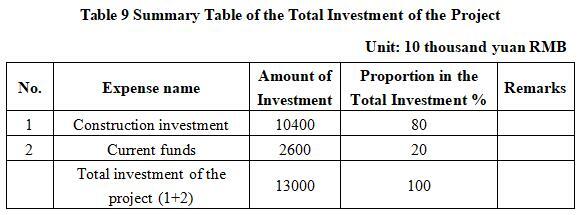
1.3.2 Capital raising
Raised by the enterprise itself
1.4 Financial analysis and social evaluation
1.4.1 Main financial indexes
After the project reaches the production capacity, its annual sales income will be 130 million yuan, its profit will be 28 million yuan, its investment payback period will be 6.6 years (after the tax, including the construction period of 2 years), and its return on investment will be 21.5%.
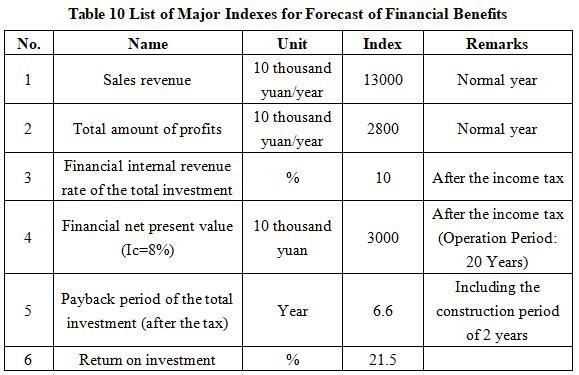
Note: “10 thousand yuan” in the table is in RMB
1.4.2 Social evaluation
Through the construction of the project, it is possible to effectively integrate the traditional Chinese medicinal material resources in the surrounding areas, fully utilize the location advantages of Dongfeng County, and create a centralized traditional Chinese medicinal material trading center that integrates trading, product display, warehousing and logistics, e-commerce, and financial services, etc. of traditional Chinese medicinal materials. This can further enhance the competitiveness and popularity of the traditional Chinese medicinal material industry, promote the extension of the traditional Chinese medicinal material industry chain, radiate and drive the prosperous development of the traditional Chinese medicinal material industry in the surrounding areas, and drive local employment, playing a good role in promoting local social development.
1.5 Cooperative way
Joint venture or cooperation, other ways can be discussed in person.
1.6 What to be invested by the foreign party
Funds, other ways can be discussed in person.
1.7 Construction site of the project
Dongfeng County, Liaoyuan City, Jilin Province.
1.8 Progress of the project
Attracting foreign investment.
2. Introduction to the Partner
2.1Basic information
Name: Dongfeng County Key Project Service Center
Address: No. 293 Dongfeng Road, Dongfeng Town, Liaoyuan City, Jilin Province
2.2 Overview
Dongfeng County is located in the central and southern part of Jilin Province, in the residual vein of Hadaring Branch of Changbai Mountain. It is a semi-mountainous area of “five mountains, one water, and four fields”, covering an area of 2,522 square kilometers. It governs 14 townships and 3 sub-districts, with a total population of 400,000. It is the famous “Hometown of Cervus Nippon in China” and “Hometown of Farmer Painting in China”, as well as a “National Commodity Grain Base County, National Top 100 Characteristic Industry County, National Greening Advanced County, National Basic Education Advanced County, National Legal Education Advanced County, National Best Investment Environment County, National Village Cleaning Action Advanced County, and Safe China Construction Demonstration County”. It has successfully established National-level Health County, National Martial Arts Town, Chinese Poetry Town, Reading Town in Jilin Province, Provincial-level Garden County, Provincial-Level Civilized County, Provincial-level Double Support Model County, and Provincial-level Leisure Agriculture Demonstration County.
Dongfeng has abundant natural resources and beautiful scenery. Its terrain is high in the west and low in the east, surrounded by mountains and undulating hills, with lush forests, beautiful mountains and clear waters. The forest area is 87,000 hectares, with 17 large forests covering an area of 10,000 mu and a forest coverage rate of 32.9%. It is a National Afforestation and Greening Model County, One Million-Mu Artificial Forests Advanced County, National Reserve Forest Planning County, and Provincial Forest (Grass) Chief System Pilot County. It has successfully passed the preliminary review as a national garden city. It is rich in mineral and wind power resources, with huge reserves of iron, manganese, limestone, granite, and peat soil, etc., and abundant mineral water reserves. The perennial stream flow can reach 500,000 tons; The Yingcang Wind Power Project and Qingyu Wind Power Project have been put into operation. The largest substation hub in Northeast China, i.e., the “500,000 Substation”, is 10 kilometers away from the county, while the “220,000 Substation” is only 1 kilometer away from the county.
2.3 Contact method
Postal code: 136399
Contact person: Yin Shaoqing
Tel: +86-437-6317090 +86-13278450927
E-mail: swj6317090@163.com
Contact method of the city (prefecture) where the project is located:
Contact unit: Liaoyuan Municipal Bureau of Commerce
Contact person: Ai Jing
Tel: +86-18643787709
E-mail: lyjhjxmc@163.com


